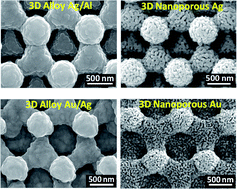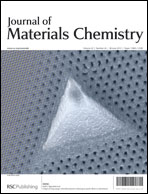Highly ordered tailored three-dimensional hierarchical nano/microporous gold–carbon architectures
Abstract
The preparation and characterization of three-dimensional hierarchical architectures, consisting of monolithic nanoporous gold or silver films formed on highly ordered 3D microporous carbon supports, are described. The formation of these nano/microporous structures involves the electrodeposition or sputtering of metal alloys onto the lithographically patterned multi-layered microporous carbon, followed by preferential chemical dealloying of the less noble component. The resulting hierarchical structure displays a highly developed 3D interconnected network of micropores with a nanoporous metal coating. Tailoring the nanoporosity of the metal films and the diameter of the large micropores has been accomplished by systematically changing the alloy compositions via control of the deposition potential, plating solution and coarsening time.


 Please wait while we load your content...
Please wait while we load your content...